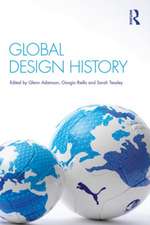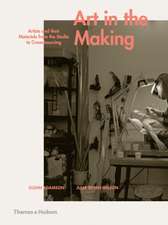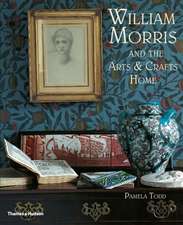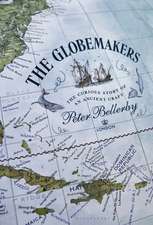The Craft Reader
Autor Glenn Adamsonen Limba Engleză Paperback – 30 sep 2018
| Toate formatele și edițiile | Preț | Express |
|---|---|---|
| Paperback (1) | 282.94 lei 3-5 săpt. | |
| Bloomsbury Publishing – 30 sep 2018 | 282.94 lei 3-5 săpt. | |
| Hardback (1) | 964.25 lei 6-8 săpt. | |
| Bloomsbury Publishing – 30 noi 2009 | 964.25 lei 6-8 săpt. |
Preț: 282.94 lei
Preț vechi: 349.48 lei
-19% Nou
Puncte Express: 424
Preț estimativ în valută:
54.14€ • 57.90$ • 45.14£
54.14€ • 57.90$ • 45.14£
Carte disponibilă
Livrare economică 28 martie-11 aprilie
Preluare comenzi: 021 569.72.76
Specificații
ISBN-13: 9781350092648
ISBN-10: 1350092649
Pagini: 656
Ilustrații: 75 b&w illustrations, bibliography, index
Dimensiuni: 189 x 246 x 39 mm
Greutate: 1.29 kg
Editura: Bloomsbury Publishing
Colecția Bloomsbury Visual Arts
Locul publicării:London, United Kingdom
ISBN-10: 1350092649
Pagini: 656
Ilustrații: 75 b&w illustrations, bibliography, index
Dimensiuni: 189 x 246 x 39 mm
Greutate: 1.29 kg
Editura: Bloomsbury Publishing
Colecția Bloomsbury Visual Arts
Locul publicării:London, United Kingdom
Caracteristici
Student friendly: themed and contextualised readings with lots of illustrations
Notă biografică
Glenn Adamson is Deputy Head of Research and Head of Graduate Studies at the Victoria and Albert Museum. He is author of Thinking Through Craft and co-editor of the Journal of Modern Craft
Cuprins
AcknowledgementsNote on the TextsIntroductionSECTION 1: HOW TOSection Introduction1. 'Introductory Remarks', from The Teacher's Handbook of Slöjd, Otto Salomon 2. Elements of Handicraft and Design, W. A. S. Benson3. The Wheelwright's Shop, George Sturt4. On Weaving, Anni Albers5. Primitive Pottery, Hal RieggerSECTION 2: CRAFT AND THE INDUSTRIAL REVOLUTIONSection Introduction6. On the Economy of Machines and Manufactures, Charles Babbage7. Artisans and Machinery, Peter Gaskell8. 'How an Aristocracy May Emerge from Industry', from Democracy in America, Alexis de Tocqueville9. Industrial Biography: Iron Workers and Tool Makers, Samuel Smiles10. Capital, Karl Marx11. 'The Primary Effects of Scientific Management', from Labor and Monopoly Capitalism, Harry Braverman12. The Workshop of the World: Steam Power and Hand Technology in Mid-Victorian Britain, Raphael Samuel13. Technological Innovation and Design Economics in Furniture Manufacture, Michael Ettema14. Artistic America, Siegfried Bing15. In the Cause of Architecture: The Architect and the Machine, Frank Lloyd Wright16. Art and the Machine, Hermann Muthesius17. Building Materials, Adolf Loos18. Handwerk/Kunsthandwerk, Stefan MuthesiusSECTION 3: MODERN CRAFT: IDEALISM AND REFORMSection Introduction19. 'The Nature of the Gothic', from The Stones of Venice, John Ruskin20. The Revival of Handicraft, William Morris21. Art and Labor, Ellen Gates Starr22. Art and Workmanship, W. R. Lethaby23. 'Slogans', 'The Work Ahead of Us' and 'The Problem of the Relationship Between Man and Object', Vladimir Tatlin24. 'The Way of Craftsmanship', from The Unknown Craftsman: A Japenese Insight into Beauty, Sôetsu Yanagi25. A Potter's Book, Bernard Leach26. Initiation and the Crafts, René Guénon27. Indian Handicrafts, Kamaladevi Chattopadhyay28. 'The Relation of the Past to the Demands of the Present', World Crafts Conference proceedings (1964)29. Centering, M. C. Richards30. Introduction to Craftsman Lifestyle: The Gentle Revolution, Eudorah Moore31. The Soul of a Tree, George Nakashima32. The Long Shadow of William Morris: Paradigmatic Problems of Twentieth-Century American Furniture, Edward S. Cooke, Jr.SECTION 4: THE PRESENCE OF CRAFT IN THE AGE OF MASS PRODUCTIONSection introduction33. The Shoemaker of Dreams, Salvatore Ferragamo34. Crafting Grand Cru Chocolates in Contemporary France, Susan J. Terrio35. From Peasant to Artisan: Motor Mechanics in a Nigerian Town, Sara Berry36. Destiny World: Textile Casualties in Southern Nigeria, David T. Doris37. On a Particular Kind of Love and the Specificity of Soviet Production, Sergei Alasheev38. Original Copies, Philip Tinari39. What is Cybernetics?', from The Human Use of Humans, Norbert Wiener40. Abstracting Craft: The Practiced Digital Hand, Malcolm McCullough41. 'Digital Artisans Manifesto', European Digital Artists Network, Richard Barbrook and Pit Schultz 42. Craft Versus Design: Moving Beyond a Tired Dichotomy, Rafael CardosoSECTION 5: CRAFT IN THEORY: AESTHETICS, ESSENCE, STATUSSection Introduction43. The Nature and Art of Workmanship, David Pye44. 'The Genesis of the Technical Object: The Process of Concretization', from Du Mode d'Existence des Objets Techniques, Gilbert Simondon45. 'Forms in the Realms of Matter' from The Life of Forms in Art, Henri Focillon46. Rhythm, Elsie Fogerty47. The Mande Blacksmiths: Knowledge, Power and Art in West Africa, Patrick R. McNaughton48. African Art: Where the Hand Has Ears, Amadou Hâmpaté Bâ49. Walter Benjamin: Traces of Craft, Esther Leslie50. Functionalism Today, Theodor Adorno51. The Thing, Martin Heidegger52. Rappel a l'Ordre: The Case for the Tectonic, Kenneth Frampton53. 'Art and Craft', from The Principles of Art, R. G. Collingwood54. Art and Work, Harold Rosenberg55. 'Comment' and Responses, John Bentley Mays56. Curatorial Comment from The Maker's Eye, Alison Britton57. How Envy Killed the Crafts, Garth ClarkSECTION 6: CRAFT IN ACTION: LIFE, ART, DESIGNSection introduction58. The Enchantment of Technology and the Technology of Enchantment, Alfred Gell59. Making Something from Nothing (Toward a Definition of Women's 'Hobby Art'), Lucy Lippard60. 'The Creation of Femininity', from The Subversive Stitch: Embroidery and the Making of the Feminine, Rozsika Parker61. There's No Place Like Home: Home Dressmaking and Creativity in the Jamaican Community of the 1940s to the 1960s, Carole Tulloch62. House-Trained Objects: Notes Towards Writing an Alternative History of Modern Art, Tanya Harrod63. The New Ceramic Presence, Rose Slivka 64. How I Spent My Summer Vacation or, Art and Politics in Nevada, Berkeley, San Francisco and Utah, Philip Leider65. Some Notes on the Phenomenology of Making: The Search for the Motivated, Robert Morris66. The Art of the Encounter, Lee Ufan67. Let the Artisans Craft Our Future, Grayson Perry68. 'Manifesto of the Bauhaus' and 'Education and the Bauhaus', Walter Gropius and László Moholy-Nagy69. Shaping America's Products, Don Wallance70. Asilomar Conference Proceedings 1957, Marguerite Wildenhain and Charles Eames71. 'The New Handicrafts', from Hot House, Andrea BranziSECTION 7: CURATORIAL APPROACHESSection Introduction72. Affectivity and Entropy: Production Aesthetics in Contemporary Sculpture, Johanna Drucker73. 'Craftsmen in the Factory of Images', from BoysCraft, Tami Katz-Frieberg74. And What is Your Title? Zandra Ahl75. Craft Hard, Die Free: Radical Curatorial Strategies for Craftivism in Unruly Contexts, Anthea Black and Nicole Burisch76. The Politics of Craft: A Roundtable, Julia Bryan-Wilson, Liz Collins, Sabrina Gschwandtner, Cat Mazza and Allison SmithRecommended BibliographyList of Illustrations Index
Recenzii
The scope of the Craft Reader is breathtaking. Finally, here is a text that successfully contextualizes the diverse range of writings on craft. By gathering these thoughts into a clearly articulated set of arguments Adamson has helped to shape the field of craft discourse. This book will stand as an invaluable tool for craft scholars.
A much needed outline history of 19th and 20th century crafts within a wide social and cultural context, as well as an overview of the most important issues in crafts today.
This anthology confirms, in multiple ways across a century and a half of continual practice and debate, that the presence of craftsmanship is virtually inseparable from the design and realization of the material world.
Glenn Adamson's Craft Reader is the rarest of anthologies: at once an excellent and wide-reaching compilation of craft scholarship, and a provocative challenge to the same.
The idea of craft has jumped to the forefront of creative work. The many young artisans now engaged in digital fabrication, tangible interfaces, and do-it yourself electronics may enjoy reflecting on the few who kept craft alive through the industrial night, and on those whose theories and practices belong in any technological age. This astute collection gives rich context to all such thought.
Thought-provoking, revealing, opinionated, intelligent, accessible and comprehensive ... a huge achievement.
This new attention to craft, to work done through some close contact between hand and thing, has been enriched by the publication of The Craft Reader, an imposing compendium edited by Glenn Adamson, an American who is head of graduate studies and deputy head of research at the Victoria and Albert Museum in London. He has cast his net wide for this anthology, which covers two centuries of thinking by craftsmen, critics, historians, anthropologists and philosophers, including ones you might not have thought would have much to say. Alongside the proper high-class makers like Anni Albers, Bernard Leach and George Nakashima we find Alexis de Tocqueville rubbing shoulders with Karl Marx; Lee Ufan, the Korean-Japanese protagonist of the Mono-ha ("school of things") art movement, with Norbert Wiener, the father of cybernetics; and Samuel Smiles, the original self-help guru whose very name became a byword for philistine Victorian optimism, with Theodor Adorno, the glowering negative dialectician from Frankfurt. Although the book has been edited with a student readership in mind, its kaleidoscopic mix of materials means it can open fresh perspectives for anyone interested in crafts; and even readers who think they're not interested in craft will be more engaged than they expected, if they give the anthology half a chance.
This thick volume is a compendium of articles on contemporary craft. The subjects examined cover a period of time from the industrial revolution and the canonical texts of the movement "Arts & Crafts" until today. Course covers topics on the new esthetic ceramics or weight of tradition.
A much needed outline history of 19th and 20th century crafts within a wide social and cultural context, as well as an overview of the most important issues in crafts today.
This anthology confirms, in multiple ways across a century and a half of continual practice and debate, that the presence of craftsmanship is virtually inseparable from the design and realization of the material world.
Glenn Adamson's Craft Reader is the rarest of anthologies: at once an excellent and wide-reaching compilation of craft scholarship, and a provocative challenge to the same.
The idea of craft has jumped to the forefront of creative work. The many young artisans now engaged in digital fabrication, tangible interfaces, and do-it yourself electronics may enjoy reflecting on the few who kept craft alive through the industrial night, and on those whose theories and practices belong in any technological age. This astute collection gives rich context to all such thought.
Thought-provoking, revealing, opinionated, intelligent, accessible and comprehensive ... a huge achievement.
This new attention to craft, to work done through some close contact between hand and thing, has been enriched by the publication of The Craft Reader, an imposing compendium edited by Glenn Adamson, an American who is head of graduate studies and deputy head of research at the Victoria and Albert Museum in London. He has cast his net wide for this anthology, which covers two centuries of thinking by craftsmen, critics, historians, anthropologists and philosophers, including ones you might not have thought would have much to say. Alongside the proper high-class makers like Anni Albers, Bernard Leach and George Nakashima we find Alexis de Tocqueville rubbing shoulders with Karl Marx; Lee Ufan, the Korean-Japanese protagonist of the Mono-ha ("school of things") art movement, with Norbert Wiener, the father of cybernetics; and Samuel Smiles, the original self-help guru whose very name became a byword for philistine Victorian optimism, with Theodor Adorno, the glowering negative dialectician from Frankfurt. Although the book has been edited with a student readership in mind, its kaleidoscopic mix of materials means it can open fresh perspectives for anyone interested in crafts; and even readers who think they're not interested in craft will be more engaged than they expected, if they give the anthology half a chance.
This thick volume is a compendium of articles on contemporary craft. The subjects examined cover a period of time from the industrial revolution and the canonical texts of the movement "Arts & Crafts" until today. Course covers topics on the new esthetic ceramics or weight of tradition.
Descriere
Descriere de la o altă ediție sau format:
A collection for students of the key writings - classic and contemporary - on all aspects of Craft History, Theory & Practice
A collection for students of the key writings - classic and contemporary - on all aspects of Craft History, Theory & Practice









